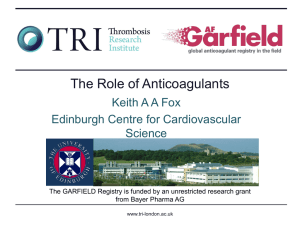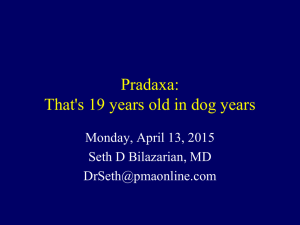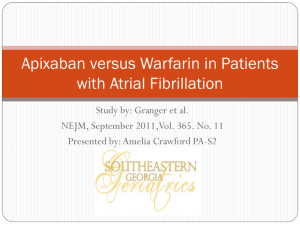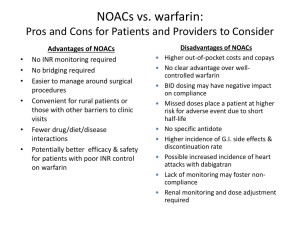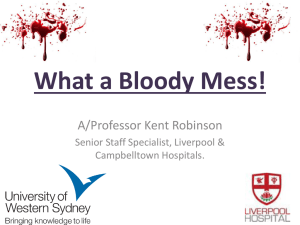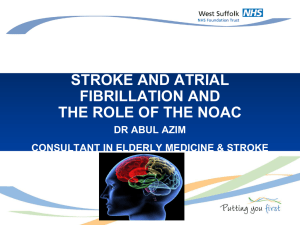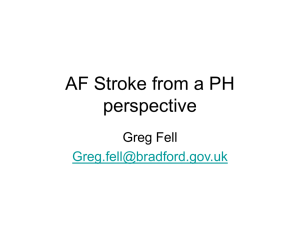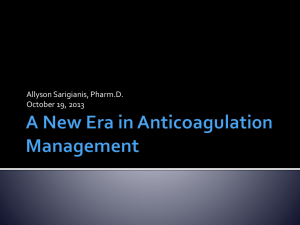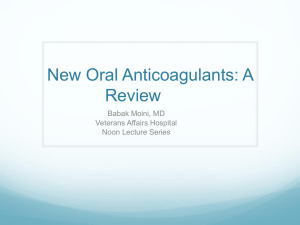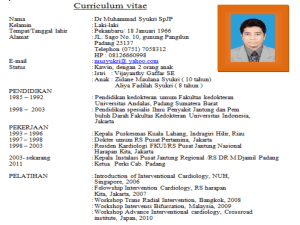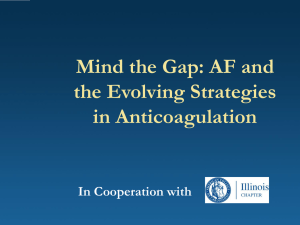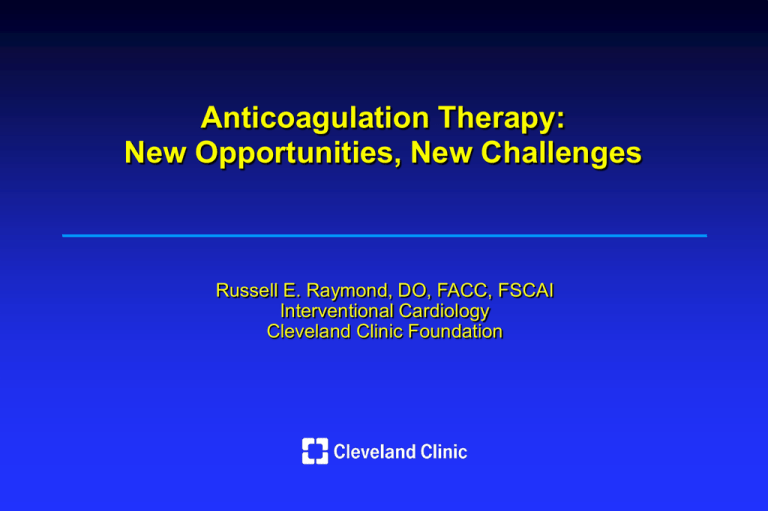
Anticoagulation Therapy:
New Opportunities, New Challenges
Russell E. Raymond, DO, FACC, FSCAI
Interventional Cardiology
Cleveland Clinic Foundation
Disclosures
Russell E. Raymond, DO, FACC, FSCAI
Interventional Cardiology
Cleveland Clinic Foundation
New Kid On The Block
Russell E. Raymond, DO, FACC, FSCAI
Interventional Cardiology
Cleveland Clinic Foundation
Indications for Oral Anticoagulation
Multiple clinical trials and guideline statements support
the use of long-term oral anticoagulation for stroke
prevention in high-risk patients with atrial fibrillation
(AF).1–8
Long-term oral anticoagulation is also a mainstay in the
management of patients with:
— Mechanical heart valves
— Deep venous thrombosis (DVT)
— Pulmonary embolism
Developmental History –
Current FDA Approved
Anticoagulants
1930s
Heparin
1950s
Warfarin
1970s
1980s
1990s
2002
2010-12
LMWHs
DTIs
Enoxaparin
Dalteparin
Tinzaparin
Argatroban
Bivalirudin
Lepirudin
Iprivask
Factor Xa
inhibitor
DTI and
Factor Xa
inhibitors
Fondaparinux
Dabigatran
Rivaroxaban
Apixaban
Disadvantage of Current Anticoagulants
Narrow therapeutic index
Need for frequent monitoring
Slow onset and offset of action
Route of administration
Large inter-individual dosing differences
Drug-Drug and drug-food interactions
Genetic polymorphisms
Complications of Current Anticoagulants
Bleeding
New Thrombosis
Heparin-induced thrombocytopenia
Warfarin skin necrosis
Osteoporosis
Warfarin embryopathy
Coagulation Cascade
Tissue
Factor
XIIa
XIa
VIIa
IXa
Xa
Intrinsic Pathway
Extrinsic Pathway
Factor II
(Prothrombin)
Fibrinogen
Fibrin Clot
Vitamin K Sensitive Factors
Tissue
Factor
XIIa
XIa
VIIa
IXa
Xa
Intrinsic Pathway
Extrinsic Pathway
Factor II
(Prothrombin)
Fibrinogen
Fibrin Clot
© 2013 American College of Chest Physicians
Coagulation Cascade
Schematic diagram of the
coagulation cascade along the
tissue factor pathway and the
targets of direct factor Xa and
thrombin inhibitors. The vitamin
K antagonist warfarin typically
works on several calciumdependent clotting factors,
including factors II, VII, IX (not
shown), and X.
Warfarin Reduces Stroke Risk in AF by 67%
Warfarin Better
Control Better
AFASAK
SPAF
BAATAF
CAFA
SPINAF
EAFT
Aggregate
100%
50%
Hart R et al. Ann Intern Med. 2007;146:857.
0
-50%
-100%
Optimal INR in AF
15
Odds Ratio
Stroke
Intracranial Hemorrhage
10
5
1
0
1.0
2.0
3.0
4.0
5.0
6.0
International Normalized Ratio (INR)
Fuster et al. J Am Coll Cardiol. 2001;38:1231.
Oden et al. Thromb Res. 2006;117:493.
7.0
8.0
CHADS2 Score for Stroke Risk
Stratification in AF
Annual Risk of Stroke (%)
Risk Factor
Score
20
18
Congestive Heart Failure (CHF)
1
Hypertension (HT)
1
14
Age > 75 years
1
12
Diabetes
1
Stroke
2
16
8.5
8
5.9
6
2
Gage BF et al. Circulation. 2004;110:2287.
12.5
10
4
0 points .......low risk
1-2 points ....moderate risk
> 3 points ... high risk
18.2
4.0
1.9
2.8
0
0
1
2
3
4
Total Score
5
6
Stroke
Stroke is 5 times more
likely in patients with
atrial fibrillation
compared with those
without.
A CVA during atrial
fibrillation is twice as
likely to cause death
and disability
compared with non
embolic strokes
Stroke Risk Stratification in AF
CHADS2-VASc
Risk Factor
Score
Annual Risk of Stroke (%)
20
CHF
1
18
HT
1
16
CHADS2-VASc
15.2
14
Age > 75 years
1
Diabetes
1
10
Stroke
2
8
Vascular Disease
1
6
12
9.8
6.7
1
Sex category
1
6.7
4.0
4
Age 65-74 years
3.2
2.2
1.3
2
0
0.0
0
1
2
3
4
5
6
Total Score
Lip GY et al. Am J Med. 2010;133:484.
Camm J et al. Eur Heart J. 2010;31:2369.
9.6
7
8
9
Stroke Risk Stratification in AF
CHADS2
Risk Factor
CHF
HT
Age > 75 years
Diabetes
Stroke
Score
1
1
1
1
2
Annual Risk of Stroke (%)
20
CHADS2
CHADS2-VASc
18
15.2
16
14
12
CHADS2-VASc
Risk Factor
CHF
HT
Age > 75 years
Diabetes
Stroke
Vascular Disease
Age 65-74 years
Sex category
9.8
10
Score
1
1
1
1
2
1
1
1
8
9.6
6.7
6.7
6
4.0
4
3.2
2.2
1.3
2
0.0
0
0
1
2
3
Lip GY et al. Am J Med. 2010;133:484. Camm J et al. Eur Heart J. 2010;31:2369.
Miyasaka, et al Circulation 2006; 114:119-125
4
5
6
7
8
9
Bleeding Risk Scores in AF
ATRIA
HAS-BLED
Anemia
3 HT
Severe renal
disease
3
Age ≥ 75 years
HEMORR2HAGES
1
Hepatic or renal disease
1
1
Ethanol abuse
1
2 Stroke
1
Malignancy
1
Any prior
hemorrhage
1 Bleeding
1
Older age (> 75 years)
1
HT
1 Labile INR
1
Reduced platelet count or
function
1
Elderly (> 65 years)
1
Rebleeding
2
Drug or alcohol use
1
HT
1
Anemia
1
Genetic factors
1
Excessive fall risk
1
Stroke
1
Abnormal renal or liver
function
Apostolakis S et al. J Am Coll Cardiol. 2012;60:861.
Warfarin
But...
Effective
Reversible
Inexpensive
Slow onset of action
Needs regular monitoring
Interaction with food
Interacts with medications
Difficult titration-regular dose
adjustments
Barriers to Warfarin Use
Reasons why physicians don’t use coumadin:
— Risk of hemorrhage:
2.0
— Risk of embolus too low:
3.4
— Patient Refusal:
3.6
— Inconvenience of monitoring:
5.2
— Impairs quality of life:
5.2
— Belief that aspirin is superior:
5.2
— Cost:
5.6
— Doubt effectiveness:
6.8
McCrory, et al. Arch Int Med, 1995
The Ideal Oral Anticoagulant
Ideally, an oral anticoagulant would:
Require no remote monitoring
Have little interaction with food or other drugs
Offer a good safety profile with regard to bleeding risk
Have similar efficacy to warfarin in reducing
thromboembolic events
Reach therapeutic levels within several hours
Oral and/or IV administration
Ability to inhibit free and clot bound thrombin
Availability of an antidote
New Oral Anticoagulants (OACs)
Tissue
Factor
XIIa
XIa
VIIa
IXa
Xa
Rivaroxaban
Apixaban
Dabigatran
Factor II
(Prothrombin)
Fibrinogen
Fibrin Clot
New OACs
Characteristic
Apixaban
Dabigatran Rivaroxaban
Direct factor inhibition
Xa
IIa
Xa
Bioavailability, %
80
6
80
Peak action, h
1-3
1-3
1-3
Protein binding, %
84
35
92
Renal clearance, %
25
80
33
Elimination T1/2 CrCl > 80
mL/min, h
15.1
13.8
8.3
Elimination T1/2 CrCl < 30
mL/min, h
17.3
27.5
9.5
Novel Oral Anticoagulants (NOACs)
Pivotal DB, PC, RCTs vs Warfarin
Dabigatran
—RE-LY
ALL SHOWED
Non-inferiority compared
with Vitamin K Antagonists
(VKA)
Better safety
Rivaroxaban
—ROCKET-AF
Apixaban
—ARISTOTLE
—Reduced ICH
Dabigatran (n=18,114) Versus Warfarin in Patients With
AF
(RE-LY Trial)
4.0
Dabigatran 110
Dabigatran 150
Warfarin
3.5
3.0
*
2.5
2.0
AF
≥1 risk factor
18,000 patients, 951 centers in 44 countries
*
1.5
*
1.0
*
*
0.5
0.0
CVA/Embolism
Major Bleed
Connolly S et al. N Engl J Med. 2009;361:1139.
ICH
MI
GI Bleed
Rivaroxaban (n=14,264) Versus Warfarin in
Nonvalvular AF (ROCKET-AF)
4.0
3.5
14,264 patients with AF and risk of stroke
Noninferiority trial
Prespecified on-treatment analysis
Rivaroxaban
Warfarin
3.0
2.5
P < .001
P < .001
2.0
1.5
1.0
P = .02
0.5
0.0
Stroke/Embolism On Stroke/Embolism ITT
Treatment
Patel MR et al. N Engl J Med. 2011;365:883.
Major Bleeding
ICH
Apixaban (n=18,201) Versus Warfarin in Patients
With AF (ARISTOTLE)
4.0
3.5
P = .047
Apixaban
Warfarin
P < .001
3.0
2.5
2.0
P = .01
1.5
1.0
P < .001
0.5
0.0
CVA/Embolism
Major Bleeding
Granger CB et al. N Engl J Med. 2011;365:981.
ICH
Mortality
New OACs: Meta-Analysis
All Cause Stroke/Systemic Embolism
Ischemic and Other Stroke
Hemorrhagic Stroke
Miller CS et al. Am J Cardiol. 2012;110:453.
New OACs: Adverse Events
Major Bleeding
Intracranial Bleeding
Gastrointestinal Bleeding
Miller CS et al. Am J Cardiol. 2012;110:453.
Dabigatran Associated With Higher
Risk of Acute Coronary Events
Meta-Analysis of Noninferiority Randomized Controlled Trials
Risk of MI or ACS
Increased Risk: 33%
Absolute Increase 0.4%
Mechanism unclear
Uchino K et al. Arch Intern Med. 2012;172:397.
Dabigatran and Bleeding
At present, the FDA is evaluating the post-marketing reports of
serious bleeding in patients taking Pradaxa submitted to the
Adverse Events Reporting System (AERS) database. While serious,
even fatal events have been reported, the FDA is analyzing the
events to determine whether the reports of bleeding in patients
taking Pradaxa are occurring more commonly than would be
expected
Dabigatran and Postmarketing
Reports of Bleeding
“The Mini-Sentinel assessment suggests that bleeding rates associated with dabigatran are not
higher than those with warfarin, a finding that is consistent with the results of RE-LY.”
Southworth MR et al. N Engl J Med. 2013;368:14.
Can the Intensity of Anticoagulation
With New OACs Be Measured?
Not especially well right now...
Coagulation Assays
Dabigatran
Rivaroxaban
Apixaban
Prothrombin time
Not useful
Qualitative
Not useful
Activated partial
thromboplastin time
Qualitative
Not useful
Not useful
Thrombin time
dTT/HEMOCLOT*
Qualitative
Quantitative
No effect
No effect
No effect
No effect
Chromogenic assays
Anti-Xa†
Anti-IIa
No effect
Quantitative
Quantitative
No effect
Quantitative
No effect
*Not currently approved by the US FDA.
†Needs to be calibrated for specific drug.
Can New OACs Be Reversed?
Variable
Dabigatran
Rivaroxaban
Apixaban
In vitro
No data
No data
Human volunteers
No data
No data
Hemoperfusion with
activated charcoal
In vitro
No data
No data
Fresh frozen plasma
Mouse model
No data
No data
Activated factor VIIa
Rat model
Rat and baboon
model
No data
No data
No data
No data
Human volunteers
Human volunteers
No data
Oral activated charcoal
Hemodialysis
3-factor prothrombin
complex concentrate (PCC)
4-factor PCC
Kaatz S et al. Am J Hematol. 2012;(87 suppl 1):S141.
Reversal of New OACs: Suggestions
Variable
Oral activated charcoal
Hemodialysis
Hemoperfusion with activated
charcoal
Fresh frozen plasma
Activated factor VIIa
3-factor PCC
4-factor PCC
Kaatz S et al. Am J Hematol. 2012;(87 suppl 1):S141.
Dabigatran
Rivaroxaban
Apixaban
Yes
Yes
Yes
No
Yes
No
Yes
Possible
Possible
No
Unclear
Unclear
Possible
No
Unclear
Unclear
Possible
No
Unclear
Unclear
Possible
Suggested interventions for patients with bleeding
due to the new OAC drugs
General Measures:
Access vital signs and resuscitate appropriately
Withdraw the anticoagulant
Periodically assess blood count and coagulation cascade
Gastric lavage and activated charcoal if within 3 hours of dose
Severe Bleeding:
ICU and multidisciplinary team care
Mechanical compression of accessible sites
Surgical intervention if appropriate
Hemodialysis (only Dabigatran)
Nonspecific prohemostatic agents (Activated prothrombin complex concentrate 50100 U/kg IV (preferred), Recombinant factro VIIa 120 U/kg)
Switching to NOAC
Coumadin:
—INR < 2 start immediately
—2<INR<2.5 start the next day
—INR > 2.5 wait and recheck INR
LMWH
—Start at the time of the next dose
Unfractionated
Heparin:
—Start at the time you stop heparin
Switching From NOAC
To
Warfarin
— Start both
— Monitor INR closely
— Discontinue NOAC when INR>= 2
To
UFH or LMWH
— Start them when it is time for the next pill
To
another NOAC
— Start it when it is time for the next pill
Dual Antiplatelet Therapy (DAPT)
Instead of OACs
In patients who cannot take OACs
In addition to OACs
DAPT Versus Oral Anticoagulation
Clopidogrel plus aspirin versus oral
anticoagulation for AF in the Atrial Fibrillation
Clopidogrel Trial with Irbesartan for prevention of
Vascular Events (ACTIVE W): A randomized
controlled trial1
Effect of Clopidogrel Added to Aspirin in Patients
with Atrial Fibrillation2
1. ACTIVE Investigators. Lancet. 2006;367:1903.
2. ACTIVE Investigators. N Engl J Med. 2009;360:2066.
ACTIVE-W: Clopidogrel Plus Aspirin
Versus Oral Anticoagulation in AF
6,706 patients with AF and increased stroke risk ( 1 of: age > 75 years, HT, previous stroke or TIA, EF <
45%, PVD, aged 55-75 versus and DM or CAD)
Aspirin 75-100 mg + clopidogrel 75 mg versus warfarin to INR 2.0-3.0
1° EP: composite of stroke, MI, non-CNS embolization, vascular death
Primary EP
Stroke
Major bleeding 2.4% clopidogrel/ASA versus 2.2%/year warfarin; RR = 1.1, P = .57
ACTIVE Investigators. Lancet. 2006;367:1903.
ACTIVE-A: Effect of Clopidogrel
Added to Aspirin in Patients With AF
ACTIVE A: 7,554 patients with AF and increased stroke risk deemed unsuitable
for warfarin
Aspirin 75 mg + placebo or clopidogrel 75 mg
1° EP: composite of stroke, MI, non-CNS embolization, vascular death
Primary EP
Stroke
Major bleeding 2.0% clopidogrel versus 1.3%/year placebo; RR = 1.57, P < .001
ACTIVE Investigators. N Engl J Med. 2009;360:2066.
Triple Therapy (DAPT plus OAC):
Trifecta or Triple Threat?
Patients with coronary stents require dual antiplatelet therapy
(DAPT) with aspirin plus clopidogrel or prasugrel or ticagrelor
Patients with AF and coronary artery disease (CAD) can have
acute coronary events necessitating stenting
Patients with CAD and stents can develop AF
DAPT not as effective as oral anticoagulation for stroke prevention
in AF
Triple Therapy Increases Bleeding Risk
44.4% at 1 year in the WOEST trial, an open-label study in
573 patients on oral anticoagulation undergoing
percutaneous coronary intervention (PCI)
Most of the oral anticoagulation was with warfarin
Little data on the combination of new oral
anticoagulations with dual antiplatelet therapy
DeWilde WJ et al. Lancet. 2013;381:1107.
Strategies for Patients With Stents and AF
Avoid drug-eluting stents when you can, especially in patients
with a high-bleeding risk
— Drug-eluting stents require 6-12 months of DAPT, whereas bare
metal stents may only need 1 month
Target INR of only 2.0-2.5
May be able to use only one antiplatelet agent
In WOEST trial, clopidogrel plus an OAC had both lower
bleeding risk (19.4% vs 44.4%) and lower combined event rates
compared with triple therapy
Putting it All Together:
ACCP Guidelines
Level of Risk
ACCP
Alternative* Not Recommended
Recommendation
Low risk
(CHADS2 = 0)
No therapy
Aspirin
Oral anticoagulation
or combination
therapy with aspirin
and clopidogrel
Intermediate
risk
(CHADS2 = 1)
Oral anticoagulation
Aspirin with
clopidogrel
Aspirin
High risk
(CHADS2 = 2)
Oral anticoagulation
Aspirin with
(dabigatran vs
clopidogrel
warfarin)
Aspirin
*For patients with AF unsuitable for OACs or those who refuse them.
You JJ et al. Chest. 2012;141(2 suppl):e531S.
Putting it All Together:
Canadian Cardiovascular Society Guidelines
Assess thromboembolic risk
(CHADS2)
CHADS2 = 0
CHADS2 = 1
CHADS2 = 2
OAC
Increasing stroke risk
No antithrombotic
ASA
OAC*
OAC*
No
additional
risk factors
for stroke
Either
female sex
or
vascular
disease
Age >65
years
or
combination
female sex
and
vascular
disease
*ASA is a
reasonable
alternative
for some as
indicated by
risk/benefit
Skanes AC et al. Can J Cardiol. 2012;28:125.
Newer agents preferred
to warfarin
Optimal Candidates for Warfarin
Patients with renal insufficiency
Patients taking stable dose of warfarin and who do
not find INR testing burdensome
Patients with access to self-testing machines
Patients concerned about the lack of an evidencebased reversal strategy
Patients concerned about the costs of therapy
Optimal Candidates for New OACs
Patients who find INR testing burdensome
Patients who have trouble staying within target INR range
Patients with normal renal function
Patients who can afford the medications or can get them
Who is a Candidate for the New
Anticoagulants?
Patients who find it cumbersome to have their
warfarin (INR) monitored regularly and/or are not
near an anticoagulation clinic
Patients unable to achieve and maintain stable
International Normalized Ratios (INR) values
Patients with a potential for food or drug
interactions
Putting it All Together
Stratify patients with AF by stroke risk
Weigh bleeding risk in the balance
Choose an evidence-based strategy when you can
Match the anticoagulation regimen to the individual
patient
Thanks for your attention
Questions?
I would like to acknowledge ACC 2013 and the ACP for material
included in this presentation

